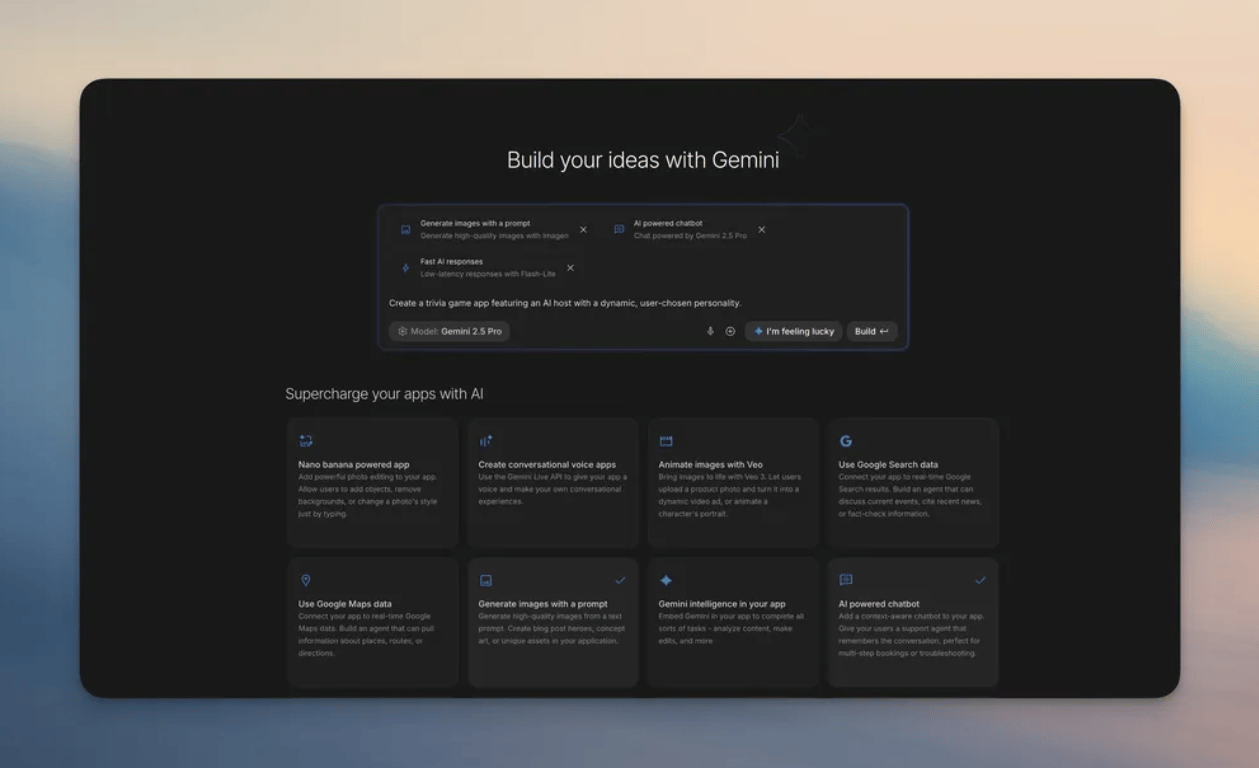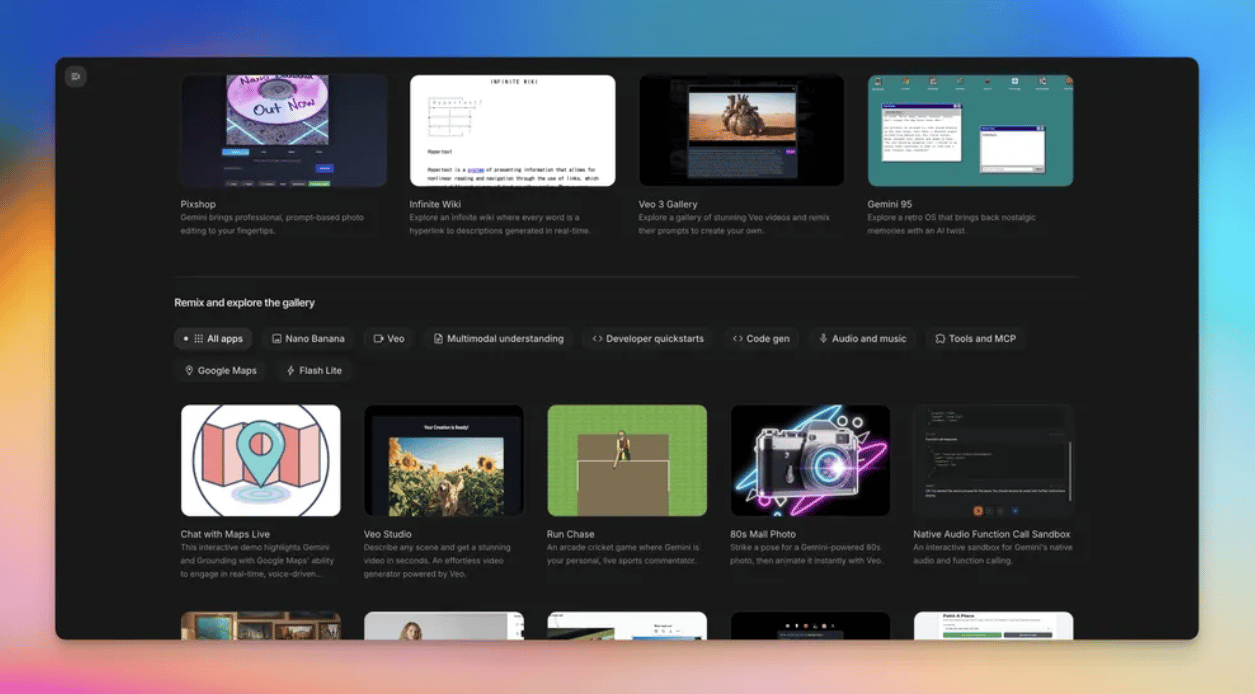
Google’s new vibe coding experience in AI Studio makes app building more visual, intuitive, and accessible — helping anyone bring multimodal ideas to life faster than ever. Image Source: ChatGPT-5
Google Introduces “Vibe Coding” to Build AI Apps in Minutes
Key Takeaways: Vibe Coding in Google AI Studio
Google launches vibe coding to build AI apps from a single prompt.
Gemini automatically connects APIs, models, and tools behind the scenes.
Developers can annotate visuals to update apps without touching code.
New inspiration features fuel ideation during loading and exploration.
The update lowers barriers for non-coders entering AI development.
Google Introduces “Vibe Coding” to Build AI Apps in Minutes
Google has rolled out a redesigned vibe coding experience inside Google AI Studio, aimed at dramatically reducing the friction of building AI-powered applications. Instead of juggling APIs, SDKs, or integration logic, developers can now describe the app they want — and Gemini handles the technical wiring automatically.
Google frames the update as a milestone in lowering the barrier between creativity and working software, enabling both developers and non-coders to prototype AI apps in minutes.
From a Single Prompt to Working Code
With vibe coding, users can simply describe the app they want:
a script-to-video generator using Veo
an image editing tool powered by Nano Banana
a writing assistant that cites sources using Google Search
AI Studio interprets requirements, selects the necessary models, and connects the right APIs automatically. The system also includes an “I’m Feeling Lucky” button that generates app concepts when users need creative inspiration.
This removes a major bottleneck: stitching multimodal capabilities manually.
App Gallery Becomes an Idea Generator
Google has refreshed the App Gallery into a visual library of projects built with Gemini. Users can:
preview demos instantly
learn from starter code
remix existing apps into your own creation
discover use-case patterns
Even wait time has been re-imagined. A new Brainstorming Loading Screen shows context-aware ideas from Gemini while your app builds, turning waiting into creative prompts for new possibilities.
Update Apps Visually with Annotation Mode
A standout new feature, Annotation Mode, allows users to point to specific elements and request changes without modifying code directly or writing long prompts for changing items.
For example, users can simply highlight a part of their app and say:
“Make this button blue.”
“Animate this image from the left.”
“Change the style of these cards.”
This natural, visual editing preserves creative flow and dramatically reduces iteration time.
Keep Momentum When Quotas Run Out
To avoid disruption, AI Studio now allows users to add their own API keys when they exceed free usage limits, then automatically switches back once quotas reset. The goal is uninterrupted prototyping.
Lowering the Barrier to AI Creativity
Google emphasizes that vibe coding is not just a feature drop — it’s part of a broader shift: democratizing AI app development. By AI assisting at every stage (idea → build → iterate), the system helps:
developers move faster
non-coders build real prototypes
teams explore multimodal concepts quickly
Google says this unlocks creative superpowers by blending ideation and execution in one continuous workflow, lowering the barrier between idea and app creation.
The company has also published a YouTube tutorial playlist to help users get started.
Q&A: Vibe Coding
Q1: Does vibe coding replace traditional development?
A: No. It accelerates prototyping, but customization still benefits from manual coding.
Q2: Can non-technical users build apps?
A: Yes. The design explicitly reduces traditional coding barriers.
Q3: Can users modify the generated code manually?
A: Yes. Gemini generates editable scaffolding for further refinement.
Q4: What models power the experience?
A: Google’s Gemini models drive multimodal capabilities behind the scenes.
Q5: Is annotation editing code-accurate?
A: Gemini interprets instructions and updates the underlying implementation accordingly.
What This Means: Vibe Coding
Vibe coding signals a shift in how software is conceived, built, and iterated. By removing the friction of wiring models, connecting APIs, and editing code manually, developers can focus more on creativity and less on configuration. Faster iteration means more room to explore ideas that may have previously been stalled by technical complexity.
For enterprises, this translates to quicker prototyping cycles and lower experimentation costs — helping organizations evaluate new concepts before fully investing in production teams. For students, hobbyists, and entrepreneurs, the technology levels the playing field, making multimodal app creation more accessible than ever before.
Looking ahead, the advantage may no longer belong to whoever writes the most code, but to those who can imagine the most compelling experiences. As technical barriers fall, ideation, user experience, ethics, and human-centered design rise in importance.
Ultimately, tools like vibe coding remind us that the future of software isn’t just about building apps faster — it’s about empowering more people to shape what technology can become.
When anyone can build with AI, imagination becomes the new infrastructure.
Editor’s Note: This article was created by Alicia Shapiro, CMO of AiNews.com, with writing, image, and idea-generation support from ChatGPT, an AI assistant used for research and drafting. However, the final perspective and editorial choices are solely Alicia Shapiro’s. Special thanks to ChatGPT for assistance with research and editorial support in crafting this article.


